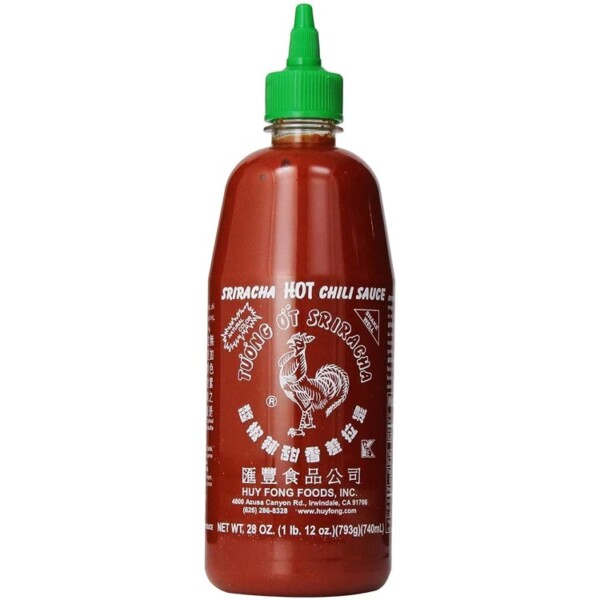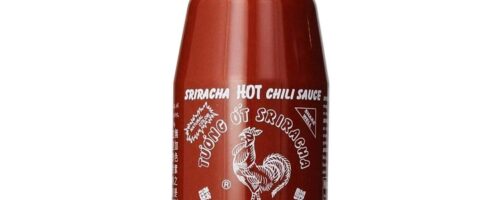
4800 Azusa Canyon Rd, Irwindale, CA 91706
How is it produced?
At the Huy Fong Foods factory in California, jalapeno peppers undergo thorough washing and inspection. Next, they are ground into a mash and stored in barrels until needed. The mash is then combined with other ingredients, and pumped into plastic bottles that are made and labelled with the iconic rooster image in the same factory.
Describe the supply chain to the store shelf in Canada:
Approximately 100,000 pounds of jalapeno peppers are shipped annually from farms in Mexico and the USA to the 650,000 square foot factory in Irwindale California. From there, the finished product is shipped (mainly by trucking) to stores and restaurants in North America.
What is the power balance between the producer and seller?
In 1988, Huy Fong Foods, entered into an agreement with Underwood Ranches (a California based company) for the supply of jalapeno peppers as a main ingredient for the then emerging hot sauce. After nearly 30 years of successful partnership between the California based manufacturer and farmer, relations started to break down in 2016. Dr. Stephanie Walker, extension vegetable specialist of New Mexico State University, speculated that Huy Fong “felt they could get cheaper jalapenos on the fresh open market” (Baker, 2023). Huy Fong filed a lawsuit against Underwood Ranches, claiming a $1.5 million overpayment for the 2016 growing season. In response, Underwood Ranches countersued, and a jury ultimately awarded them a $23 million judgment (Baker, 2023). Despite this victory, Underwood Ranches still had to pay the $1.5 million overpayment after Huy Fong switched suppliers to peppers grown in Mexico.
Huy Fong Foods’ preference for obtaining peppers at a lower cost reflects broader trends in globalization, driven by corporate profit-seeking through exploitation of less developed countries like Mexico. While some jalapeno production has continued in the USA, the breakdown of the partnership between Huy Fong and Underwood Ranches led to a significant shift in the supply of Sriracha’s jalapeno peppers. Much of the production moved to chili growing regions in Mexico,
Mexican farmers are at the mercy of agreements such as the 1944 Mexican Water Treaty and structures like the Hoover dam which regulates the flow of the Colorado river. Even when the region is experiencing drought, most of the river’s flow is diverted for municipal and agricultural purposes within the USA.
Can you recommend changes to the system to improve the balance?
There is room for major improvements in equipment usage and general safety practices within the Mexican agricultural sector. Less than a third of Mexican farm workers who have used pesticides “reported having received pesticide safety training in Mexico” and the training that was received was usually given by the party selling the chemicals (Arcury et al., 2001, p.60). Additionally, only about a third of workers experienced in pesticide handling reported using masks and gloves during their work (Arcury et al., 2001, p.60).
Huy Fong Foods should make a commitment to ensure they are sourcing peppers from farms that have set safety standards and that pay their workers fair wages.
References/Resources:
Arcury, T. A., Quandt, S. A., Rao, P., & Russell, G. B. (2001). Pesticide Use and Safety Training in Mexico: The Experience of Farmworkers Employed in North Carolina. Human Organization, 60(1), 56–66.
Baker, R. (2023, August 19). Huy Fong Foods’ sriracha shortage has been ongoing for three years. Here’s why it could have been prevented. CNBC. https://www.cnbc.com/2023/08/19/how-did-the-huy-fong-foods-sriracha-shortage-happen.html
Hampton, C. (2024, January 17). Sriracha sorrows fade as new farms harvest jalapeños. AgAlert. https://www.agalert.com/california-ag-news/archives/january-17-2024/sriracha-sorrows-fade-as-new-farms-harvest-jalape%C3%B1os/
Hernández-López, E. (2015). Sriracha: Lessons from the Legal Troubles of a Popular Hot Sauce. Gastronomica, 15(4), 27–33.
Kisken, T. (2019, April 18). Sriracha partnership flames into Ventura County court battle; $20-plus million at stake. Ventura County Star. https://www.vcstar.com/story/news/local/2019/04/18/huy-fong-foods-sriracha-sauce-lawsuit-ventura-county-jalepeno-farm/3382667002/
Morris, S. D. (2009). Political Corruption and Change in Mexico. In Political Corruption in Mexico: The Impact of Democratization (pp. 1–19). Lynne Rienner Publishers.
Polaski, S. (2004, February 25). Mexican Employment, Productivity and Income a Decade after NAFTA. Carnegie Endowment for International Peace. https://carnegieendowment.org/posts/2004/02/mexican-employment-productivity-and-income-a-decade-after-nafta?lang=en
Rosson, C. P., III, Hobbs, A., & Adcock, F. J. (2003, February). The U.S./Mexico Water Dispute: Impacts of Increased Irrigation in Chihuahua, Mexico. Southern Agricultural Economics Association Annual Meeting, Mobile, Alabama. https://doi.org/10.22004/ag.econ.35101
Udall, B., & Overpeck, J. (2017). The twenty-first century Colorado River hot drought and implications for the future. Water Resources Research, 53(3), 2404–2418. https://doi.org/10.1002/2016WR019638
United States-Mexico-Canada Agreement. (n.d.). United States Trade Representative. Retrieved May 10, 2024, from https://ustr.gov/trade-agreements/free-trade-agreements/united-states-mexico-canada-agreement
Water Education Foundation. (2020, June 22). Colorado River Water and Mexico. Water Education Foundation. https://www.watereducation.org/aquapedia/mexico-and-colorado-river-water
Wright, K., Duncan, B., Withrow, S., & Yoshimoto, B. (2016). Underwood Ranches and Huy Fong Foods: An Exclusive Relationship. Cal Poly Case Studies in Agribusiness. https://digitalcommons.calpoly.edu/agb_cs/22

